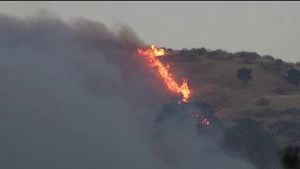The proliferation of holopelagic Sargassum spp. (Sargassum) in the tropical North Atlantic Ocean is raising alarms for coastal populations and ecosystems in the Caribbean Sea, Gulf of Mexico, and West Africa. Over the past few years, satellite detections have reported seasonal peaks in Sargassum biomass reaching between 10 to 20 million tons, marking an unprecedented environmental challenge.
A recent study, published on March 22, 2025, has utilized innovative methods combining satellite imagery with numerical simulations to estimate the significant quantities of Sargassum that accumulate on coastlines. The findings indicate that approximately 10% of the total Sargassum biomass measured offshore ends up drifting towards land, resulting in yearly accumulations of between 2 to 10 million tons along Atlantic coastlines.
This alarming shift in Sargassum blooms began around 2011 and has heightened concerns for coastal regions, especially the Mexican Caribbean, northern Lesser Antilles, and eastern Great Antilles, which are now identified as the most vulnerable areas facing severe ecosystem and socioeconomic pressures due to Sargassum influxes.
As Sargassum washes ashore, it decomposes, releasing harmful gases such as hydrogen sulfide, which can impact human health. While studies have shown that there is no immediate significant exposure risk to residents or tourists in the North-east Yucatan, cleanup workers are at a heightened risk due to their direct exposure to decomposing Sargassum. Moreover, the accumulated Sargassum is often found to be rich in heavy metals, particularly arsenic, complicating any potential use in agriculture or other sectors.
Not only does Sargassum pose health risks to humans, but it also threatens coastal ecosystems. The excessive accumulation of this macroalga can obstruct sunlight penetration, elevate water temperatures, and create anoxic conditions detrimental to marine life. In some areas, the biological fallout has already led to severe seagrass die-offs and hindered coral larvae from successfully settling and reproducing.
The vulnerable regions are grappling with increasing complexity in managing the impacts from Sargassum. Past events have resulted in a significant mortality rate among mangroves, as documented by the DEAL in Martinique, which observed high mortality rates at several sites affected by Sargassum influxes.
The research further emphasizes the critical need for accurate monitoring systems. Current satellite techniques, while beneficial for tracking Sargassum in the open ocean, do not adequately provide detailed data on coastal strandings. The complexity in transport dynamics, affected by coastal winds and currents, makes it challenging to predict where and when Sargassum will accumulate. Recent innovations in remote sensing could potentially offer a solution, bridging the gap for more effective coastal monitoring.
As researchers continue to gather more data, the development of Coastal Vulnerability Indices (CVI) has become essential. By quantifying and ranking variables that assess the impacts of Sargassum on coastal environments, scientists are providing insights that can influence local policies and preparedness strategies. The study's authors declare, “The inclusion of Sargassum stressor in CVIs has become a necessity given the significant increase in mass strandings of this brown alga on Caribbean and Atlantic coasts.”
With the current trajectory and scale of Sargassum blooms, it is essential for stakeholders—from local governments to environmental organizations—to collaborate on mitigation efforts. Continued monitoring, alongside public awareness campaigns, could help coastal communities adapt to the ensuing challenges posed by these vast Sargassum influxes.
The situation remains dynamic, and as larger datasets are compiled, the broader implications for coastal management and public health will become clearer. This creates a pressing need for enhanced observatory efforts, underpinning the serious ramifications that Sargassum blooms have for both ecosystems and human livelihoods in the affected regions.




